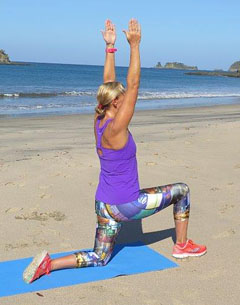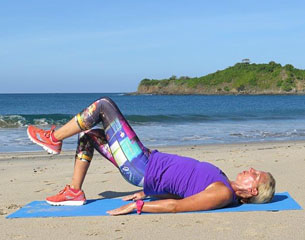
Could exercise, aimed at promoting core strength training, affect trunk angle, lateral alignment and symmetry of the rider? This was the main question up for discussion at the 11th International Society for Equitation Science (ISES) Conference after researcher Alexandra Hampson stated that previous research had identified that most riders display a preference for side laterality of the pelvis and shoulders.
“Core stability refers to an individual’s ability to control the position and motion of the trunk over the pelvis, which it can be argued has the potential to affect control of the body and limbs during athletic activities,” Dr Hampson told Eurodressage. “The physical influence of the rider is increasingly being recognized as an important contributor to equine back pain and lameness, and research demonstrates that asymmetrical loading in particular can be damaging to the horse.”
Working towards a Master’s degree in Equine Science Hampson looked for an innovative, challenging thesis topic to help both horses and riders and bring together her interests in both equine back pain and rider fitness. She began this study in the hope of examining the effects of an 8-week unmounted rider core fitness program on rider symmetry by evaluating three dependent variables; left-right saddle mean pressure difference, maximum total force of the saddle on the horse’s back, and equine stride length.
“Being a rider I know that the interactions between the horse, the saddle and the rider are complex and this is a relatively new area of research. Asymmetrical loading of the horse’s back by the rider can cause muscular tension and back pain and lead to various movement problems and lameness. Optimal performance springs from a healthy, supple equine back. A fit, balanced rider is a strong contributor to this foundation," Hampson stated.
 An unbalanced or asymmetrical rider places pressure on the horse and can even cause injury, due to the uneven weight distribution.
An unbalanced or asymmetrical rider places pressure on the horse and can even cause injury, due to the uneven weight distribution.
“We can help the horse to be happier and more comfortable in his work if we do consistent unmounted training ourselves. Many riders do not apply the same principles of athletic training to themselves as they do their horses. The dynamic duo of horse and rider is only as good as its weakest link. We have an opportunity to not be the weakest link, or at least minimize its effects. Humans and horses alike have inherent laterality: in other words, we are all a little crooked and have a preference for one side over the other. We can improve our own biomechanics and achieve greater harmony with our horses if we work on our own imbalances and symmetry while out of the saddle, as well as in it."
The major problem is that most imbalances have developed over a lifetime or are a result of injury, disability, or repetitive daily activities, such as sitting hunched over at a computer, or using one side of the body more than the other to muck stalls and sweep the barn. Hampson predicts that correction time depends on the individual and the nature of the imbalances.
“With a small amount of consistent effort, positive changes can be seen in just a few short weeks, with fairly significant changes achievable in 6-8 weeks. Old habits die hard, as coaches know, but if we address the root of the problems, such as steadily improving our neuromotor control, strength and flexibility and gradually incorporating some new daily habits, we can forge some new neural pathways and see some positive changes in our awareness, symmetry and effectiveness as riders. Addressing human spinal stability through an appropriate rider-specific exercise regime not only has a rehabilitative effect, but also a preventative one. We can limit further predisposition to injury as well as improve performance as we age," she stated.
Horses are naturally more hollow on one side and as they are carrying an asymmetrical or uneven rider on top, they will often demonstrate more difficulty with picking up the correct lead or getting their changes on one hand.
“Lateral movements may be much more difficult on one hand over the other, such as shoulder-in, half-pass, changes or pirouettes. We cannot apply truly correct aids if we are crooked. The horse may also show tension or resistance, such as heaviness in one rein, tail-swishing, coming above or behind the bit or other signs that are often interpreted as disobedience. A further sign of rider crookedness may be locomotor problems such as shortened stride length or lameness. Many types of lameness originate from back pain. The horse’s straightness and the rider’s straightness are closely linked and both must be trained in order to facilitate an optimal partnership between horse and rider.”
 In her research Hampson noted that all the riders demonstrated an asymmetrical pattern prior to a core stability program, with significant differences on the left and right sides. After the program, in addition to significant improvement in rider symmetry shown by coloured pressure maps and values generated from an electronic saddle mat, Hampson noted many positive changes in the horses.
In her research Hampson noted that all the riders demonstrated an asymmetrical pattern prior to a core stability program, with significant differences on the left and right sides. After the program, in addition to significant improvement in rider symmetry shown by coloured pressure maps and values generated from an electronic saddle mat, Hampson noted many positive changes in the horses.
“The horses showed increased straightness, more relaxation through the topline and overall improvement in performance and rideability, as reported by the riders and their coaches. The horses had longer stride strength overall after the riders completed the program and they also appeared freer in their backs. The riders clearly had an easier time sitting the trot and following the movement of their horses, which, of course, is very beneficial to the horses.”
While evidence-based resources for rider fitness are gradually improving, Hampson says that fitness classes or programs should be conducted by qualified personnel, with attention to any individual difference or special needs.
“Attending core stability classes that incorporate Pilates-type exercises can be helpful, or any exercise program followed should be balanced and include a flexibility component, i.e some type of stretching," she explained.
by Sarah Warne
Related Links
Rider Fitness: Finding that Pain Free Feeling
Physical Training for Riders: Never seen so many dressage riders in the Olympic gym
Activate Your Horse's Core
Classical Training: Work Off The Horse